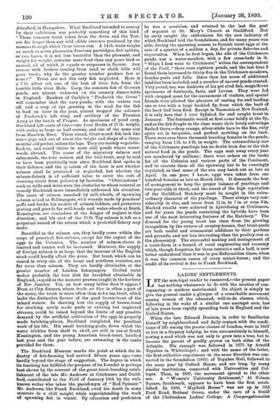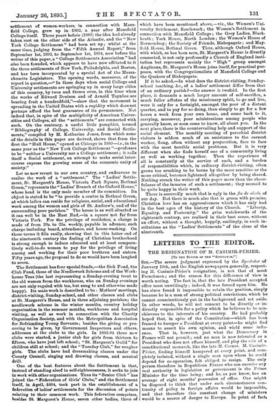LADIES' SETTLEMENTS.
ET
—thtehenipereetsieesntofpP has nothingontohnin-lgegwahl whatsoever be ertoredasoswuriethd, paper a- veyancing or matters matrimonial. Its object is simply to, give the general reader a glimpse of a remarkable movement among women of the educated, well-to-do classes, which, following in the wake of a similar one amongst men, has of late years been rapidly spreading both in England and the United States.
When the late Edward Denison, in order to familiarise- himself by neighbourhood and daily contact with the condi- tions of life among the poorer classes of London, went in 1867 to live in a Stepney lodging, he was, unconsciously to himself,. sowing a seed which was not only to grow into a tree, but to become the parent of goodly groves on both sides of the Atlantic. His example was followed in 1875 by Arnold Toynbee in Whitechapel ; and with the name of the latter, the first collective experiment in the same direction was con- nected in the foundation (1885) of Toynbee Hall, followed in the same year by Oxford House, and ere long, by many similar institutions, connected with Universities and Col- leges. Then, in 1887, the movement spread to the other sex. A " Women's University Settlement," 44 Nelson Square, Southwark, appears to have been the first estab- lished. In 1889, " Mayfield House" was set up in Old Ford Road, Bethnal Green, under the care of a Guild' of the Cheltenham Ladies' College. A Congregationalist
+settlement of women-workers, -in connection with Mans- field College, grew up in "1892, a year after Mansfield College itself. Three years befois (1:•:9) the idea had already taken root on the other side of 'the Atlantic, and the "New York College Settlement" had been set up; whilst at the same time, judging from the "Fifth Annual Report," from September 1st, 1893, to September 1st, 1894, now before the writer of this paper, a " College Settlements Association " had also been founded, which appears to have now affiliated to it the three settlements of New York,Philadelphia., and Boston, and has been incorporated by a special Act of the Massa- chusetts Legislature. The opening words, moreover, of the report in question,—" In these days when social College and Vniversity settlements are springing up in many large cities of this country, by twos and threes even, in this time when the works of Edward Denison and of Arnold Toynbee are bearing fruit a hundredfold,"—show that the movement is spreading in the United States with a rapidity which does not perhaps afford the beat guarantee of its permanence. Not indeed that, in spite of the multiplicity of American Univer- sities and` Colleges; all the " settlements " are connected with such. On 'the contrary, a useful little pamphlet, termed '" Bibliographr of College, University, and Social Settle- ments," compiled by M. Katharine Jones, from which some of the details in thit paper are derived, •shows that from the first the "Hall Hoitse," opened at Chicago in 1889—i.e., in the same year as the " New; York College Settlement "—professes to be " neither a University nor a College settlement ; it calls itself a Social settlement, an attempt to make social inter- course express the growing sense of the economic unity of society!'
Let us now revert to our own country, and endeavour to realise the work of a " settlement." The "Ladies' Settle- ment, St. Margaret's House, Victoria Park Sqhare, Bethnal Green," represents the "Ladies' Branch of the Oxford House," whose head is the only male member of its committee. Its -object is stated to be "to provide a centre in Bethnal Green, at which ladies can reside for religious, social, and educational work among the women and girls of St. Andrew's, and of the surrounding poor parishes." The house is as well situated as it can well be in the East End,—in a square not from Victoria Park. For the privilege of residefice, a charge is made of from 2fTs. to 25e. weekly, payable in advance, such charge including board, attendance, and house-washing. On these terms it fills easily, showing that in this latter end of the nineteenth century the feeling of Christian brotherhood is strong enough to induce educated and at least compara- tively well-to-do women to pay for the privilege of living among and working for their poor brethren and sisters. Fifty years ago, the proposal to do so would have been laughed to morn.
The Settlement has four special funds,—the Sick Fund, the Club Fund, those of the Needlework Scheme and of the Work- house Teas (the last representing a Sunday-evening treat to the old women from the workhouse, who on Sunday evenings are not only regaled with tea, but sung to and otherwise made happy). Its main work is described tote : Mothers' meetings, .district-visiting, Sunday-school, and other classes and clubs at St. Margaret's House, and in three adjoining parishes; the needlework scheme in the winter months, country holiday -organisation in the summer months, workhouse and hospital visiting, as well as work in connection with the Charity Organisation Society, and with the Metropolitan Association for Befriending Young Servants; besides the giving or pro- -curing to be given, by Government Inspectors and others, addresses at the clubs to the girls. In 1893.94 three new clubs were started, a junior club for girls from thirteen to fifteen, who have just left school; "St. Margaret's Guild" for children still at school; and the " Tuesday Club," for rougher girls. The clubs have had dressmaking classes under the County Council, singing and drawing classes, and musical -drill.
One of the best features about the Settlement is that, instead of standing aloof in self-righteousness, it seeks to join in work with.other organisations. Thus its "Senior Club" has joined the," Federation of Girls' Clubs," and the Settlement itself, in April, 1894, took part• in the establishment of a federation of ladies' settlements for the discussion of points relating to their common work. This federation comprises; besides St. Margaret's House, seven other bodies, three of
which have been mentioned above,—viz., the Women's Uni- versity Settlement, Southwark; the Women's Settlement in connection with Mansfield College ; the Grey Ladies, Black- heath ; York House, North London ; the Women's House of Bermondsey; the Society of Friends, Bishopsgate ; and May- field House, Bethnal Green. Thus, although Oxford House, with which, as has been seen, St. Margaret's House is directly connected, is not only professedly a Church of England insti- tution but represents mainly the "High" group amongst Anglicans, St. Margaret's House joins itself, for practical pur- poses, with the Congregationalists of Mansfield College and the Quakers of Bishopsgate.
If it be asked,—In what does the district-visiting, Sunday- school teaching, &c., of a ladies' settlement differ from that of an ordinary parish P—the answer is twofold. In the first place, it demands a much larger amount of self-sacrifice, a much fuller afflatus of the missionary spirit, to go and live, were it only for a fortnight, amongst the poor of a distant quarter, and to pay for so doing, than simply to go for a few hours a week from your own home, and come back to it, carrying, moreover, your ministrations among people who generally know, or soon come to know, all about you. In the next place, there is the countervailing help and support of the social element. The monthly meeting of parochial district visitors is seldom much of an assistance to the earnest worker, flung, often without any preparation, face to face with the most terrible social problems. Bnt it is very different when she finds herself one of a community living as well as working together. Then the experience of all is constantly at the service of each, and a burden of responsibilities which, in ordinary district-visiting, often grows too crushing to be borne by the more sensitive or the more critical, becomes lightened altogether by being shared. Nothing struck the writer of this paper more than the cheer- fulness of the inmates of such a settlement; they seemed to be quite happy in their work.
There is assuredly much that is ugly in the fin de siecle of our day. But there is much also that is green with promise. Christian love has an aggressiveness which it has only had in the best ages of the history of the Church. "Liberty, Equality, and Fraternity," the grim watchwords of the eighteenth century, are realised in their best sense, without an effort, without a thought, happily, smilingly, in such in- stitutions as the "Ladies' Settlements" of the close of the nineteenth.



















































 Previous page
Previous page